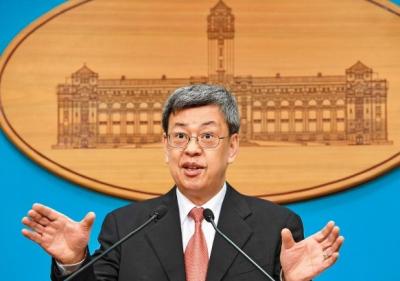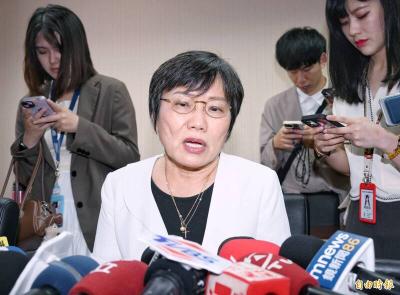Dozens of Amis Aborigines, residents of the Sanying (三鶯) Aboriginal Community in Taipei County and Kanjin (崁津) and Saowac Aboriginal Communities in Taoyuan County showed up outside the Zhongshan Police Precinct in Taipei yesterday to turn themselves in for taking part in an illegal demonstration in March.
Residents of the three communities have staged several demonstrations outside Chinese Nationalist Party (KMT) headquarters in Taipei, asking to speak to Taoyuan County Commissioner Eric Chu (朱立倫) — one of the eight KMT vice chairmen — after the Saowac Aboriginal Community was torn down by the Taoyuan County Government.
All three communities were established decades ago by Amis Aborigines from Taitung and Hualien counties after they came to work as construction workers or miners and could not afford housing in the city.
Since the houses were built without permission and because they are apparently situated in “flood zones,” the communities were subject to demolition at any time.
Sanying and Saowac have been torn down several times before, but each time they were rebuilt, while a date for the demolition of Kanjin has yet to be announced.
In March, after failing to get a response from Chu, residents of the three communities tried to force their way into KMT headquarters and clashed with police.
Earlier this week, Panai Luni, one of the leaders of the demonstration, received a ticket for a violation of the Assembly and Parade Act (集會遊行法) and was ordered to pay a fine of NT$30,000.
“This is double repression by the state — it represses our right of residency and our right of free speech,” Panai said.
Dozens of people who took part in the demonstration in March gathered outside Zhongshan Police Precinct Headquarters to turn themselves in as a show of support for Panai.
“If anyone is to be punished for taking part in the demonstration, we were all involved, we’re all ‘culprits,’ and we should all take responsibility together,” said Ko Yi-min (柯逸民), convener of Raging Citizens Act Now.
Everyone present agreed.
“I want to turn myself in. Take me,” the crowd shouted in unison as they marched about 20m from their assembly point to the front door of the precinct headquarters.
Movie director Hou Hsiao-hsien (侯孝賢) was among the crowd.
“I’m the culprit behind all the illegal demonstrations against government repression and police abuse of power,” Hou said. “I’m here to surrender myself too.”
He then handed over a list of 50 people who said they would voluntarily surrender to the police. The demonstration ended peacefully after police accepted the list.
Deputy Precinct Chief Hsu Shao-tsong (徐少聰) later told reporters that police had decided to hold Panai responsible because she was the person holding the microphone and telling the crowd to push against police at the demonstration in March.
“Our job is to find out who led the demonstration and hold that person responsible,” he said.

Taiwan would welcome the return of Honduras as a diplomatic ally if its next president decides to make such a move, Minister of Foreign Affairs Lin Chia-lung (林佳龍) said yesterday. “Of course, we would welcome Honduras if they want to restore diplomatic ties with Taiwan after their elections,” Lin said at a meeting of the legislature’s Foreign Affairs and National Defense Committee, when asked to comment on statements made by two of the three Honduran presidential candidates during the presidential campaign in the Central American country. Taiwan is paying close attention to the region as a whole in the wake of a

President William Lai (賴清德) has appointed former vice president Chen Chien-jen (陳建仁) to attend the late Pope Francis’ funeral at the Vatican City on Saturday on his behalf, the Ministry of Foreign Affairs said today. The Holy See announced Francis’ funeral would take place on Saturday at 10am in St Peter’s Square. The ministry expressed condolences over Francis’ passing and said that Chen would represent Taiwan at the funeral and offer condolences in person. Taiwan and the Vatican have a long-standing and close diplomatic relationship, the ministry said. Both sides agreed to have Chen represent Taiwan at the funeral, given his Catholic identity and

Chinese Nationalist Party (KMT) Chairman Eric Chu (朱立倫), spokeswoman Yang Chih-yu (楊智伃) and Legislator Hsieh Lung-chieh (謝龍介) would be summoned by police for questioning for leading an illegal assembly on Thursday evening last week, Minister of the Interior Liu Shyh-fang (劉世芳) said today. The three KMT officials led an assembly outside the Taipei City Prosecutors’ Office, a restricted area where public assembly is not allowed, protesting the questioning of several KMT staff and searches of KMT headquarters and offices in a recall petition forgery case. Chu, Yang and Hsieh are all suspected of contravening the Assembly and Parade Act (集會遊行法) by holding

Lawmakers from the Democratic Progressive Party (DPP) yesterday established a friendship group with their counterparts in Ukraine to promote parliamentary exchanges between the two countries. A ceremony in Taipei for the Taiwan-Ukraine Parliamentary Friendship Association, initiated by DPP Legislator Chen Kuan-ting (陳冠廷), was attended by lawmakers and officials, including Deputy Minister of Foreign Affairs Francois Wu (吳志中) and European Economic and Trade Office in Taiwan Director Lutz Gullner. The increasingly dire situation in Ukraine is a global concern, and Taiwan cannot turn its back when the latter is in need of help, as the two countries share many common values and interests,